Menus
Motorcycle fair in Milan
EICMA 2019
Presented by

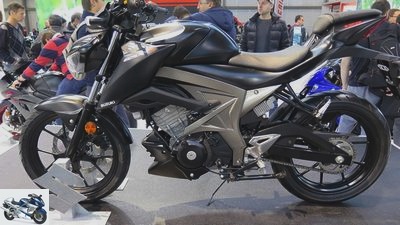
Niewrzol
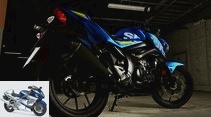
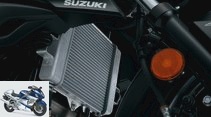
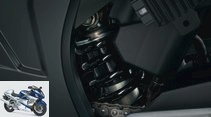
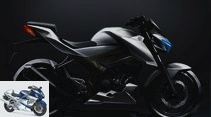
52 photos
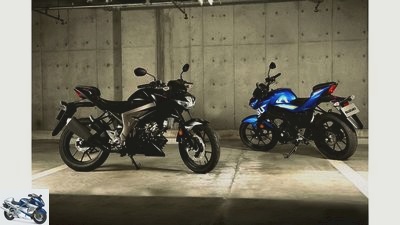
Suzuki
1/52
Suzuki GSX-S 125 at EICMA 2016.
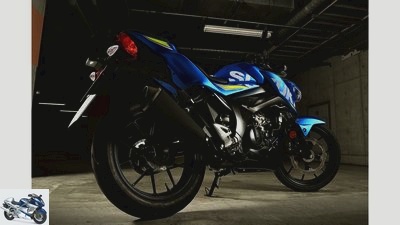
Suzuki
2/52
Suzuki GSX-S 125 at EICMA 2016.
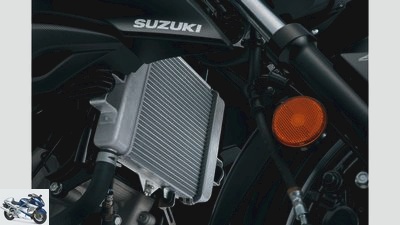
Suzuki
3/52
Suzuki GSX-S 125 at EICMA 2016.
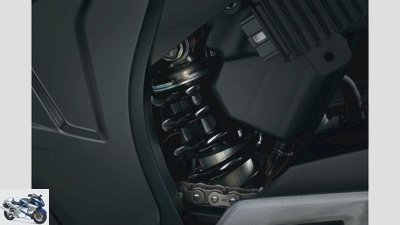
Suzuki
4/52
A central spring strut with deflection cushions and dampens the two-arm swing arm of the Suzuki GSX-S 125.
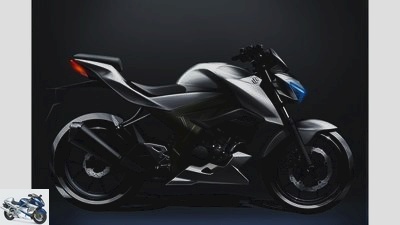
Suzuki
5/52
The Suzuki GSX-S 125 remains pleasantly close …
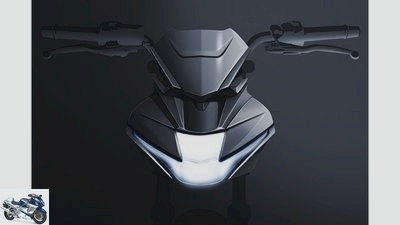
Suzuki
6/52
… on the design drafts.
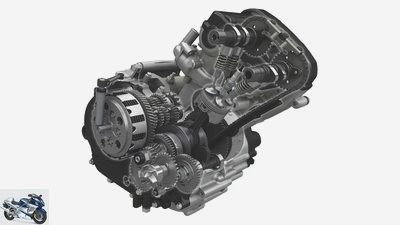
Suzuki
7/52
The engine, clutch and gearbox follow the same compact layout as the large GSX-R and GSX-S sisters.
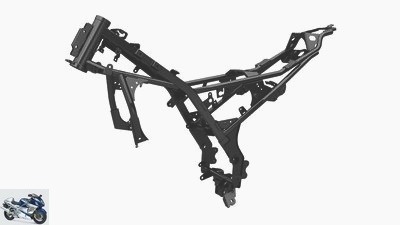
Suzuki
8/52
With its frame construction alone, Suzuki wants to achieve a weight advantage of 3 kilograms over its competitors.
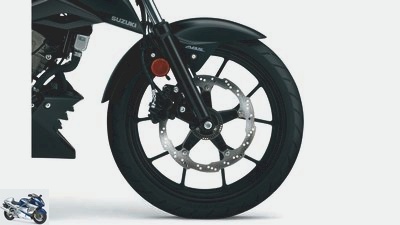
Suzuki
9/52
Filigree 10-spoke wheels and sporty designed brake discs front and rear.
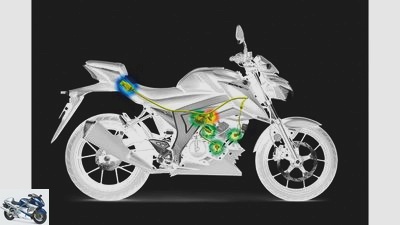
Suzuki
10/52
Six sensors provide the injection electronics with the necessary data for economical, yet powerful operation.
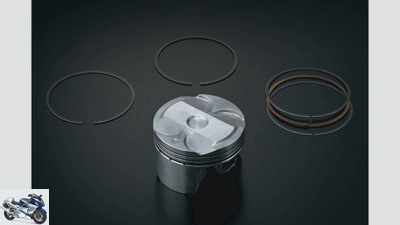
Suzuki
11/52
This comrade is exposed to constant ups and downs.
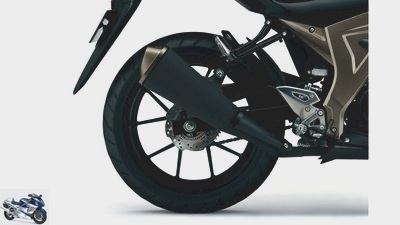
Suzuki
12/52
For loners: the passenger pegs can be removed quickly if necessary.
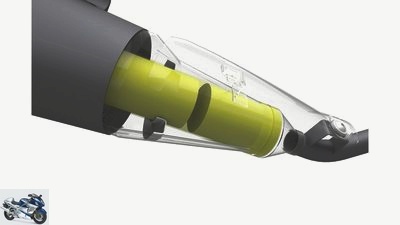
Suzuki
13/52
Euro4 demands clean exhaust gases – here the two catalytic converters placed in a row.
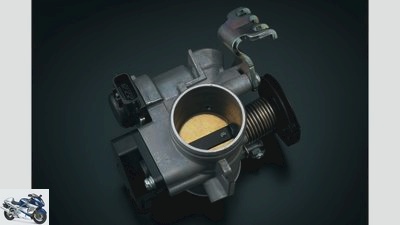
Suzuki
14/52
The 32 millimeter throttle valve does justice to the short-stroke, therefore easy-to-turn design of the Suzuki GSX-S 125.
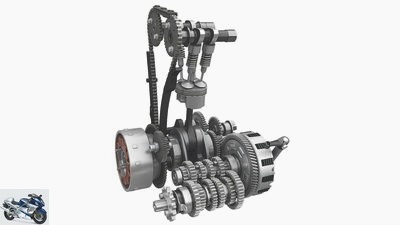
Suzuki
15/52
Two overhead camshafts with chain drive and four valves control the gas exchange of the Suzuki GSX-S 125.
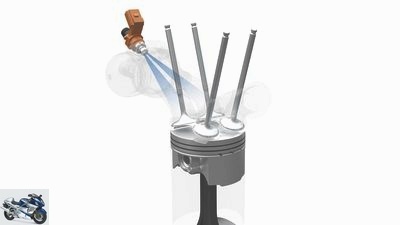
Suzuki
16/52
The injector aims directly at the intake valves.
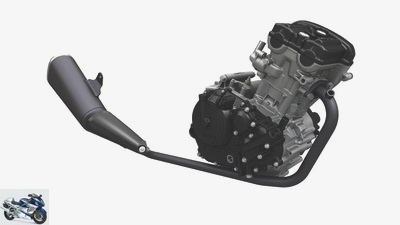
Suzuki
17/52
Engine, gearbox and exhaust pipe of the Suzuki GSX-S 125.
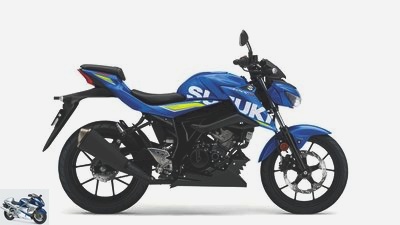
Suzuki
18/52
The Suzuki GSX-S 125 will probably be used in racing decor …
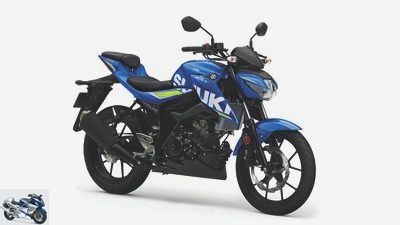
Suzuki
19/52
… cost a small extra charge. But that should …
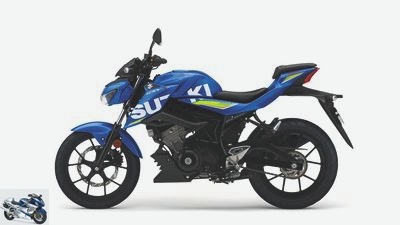
Suzuki
20/52
… not stand in the way of their success.
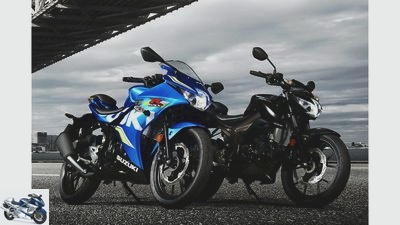
Suzuki
21/52
The Suzuki GSX-S 125 (right) is based on the GSX-R 125 sports car.
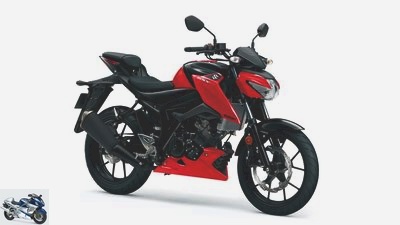
Suzuki
22/52
It’s in red …
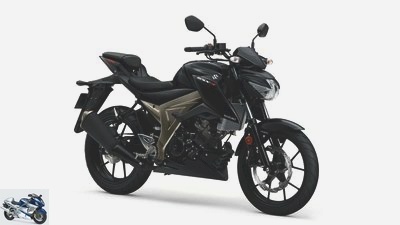
Suzuki
23/52
… in black …
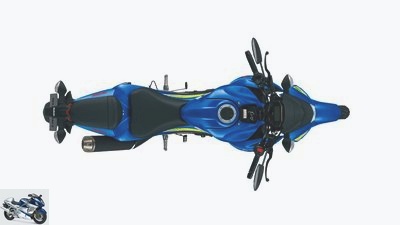
Suzuki
24/52
… as well as available in Suzuki Racing decor.
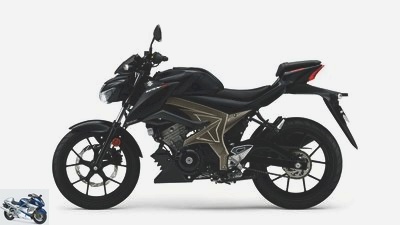
Suzuki
25/52
The manufacturer names its compact layout as the three main virtues of the Suzuki GSX-S 125 …
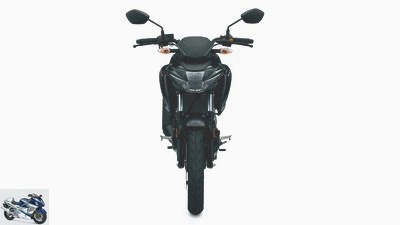
Suzuki
26/52
… their low weight …
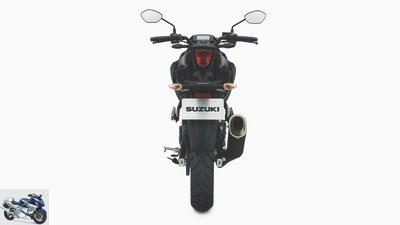
Suzuki
27/52
… as well as its easy-revving, powerful engine.
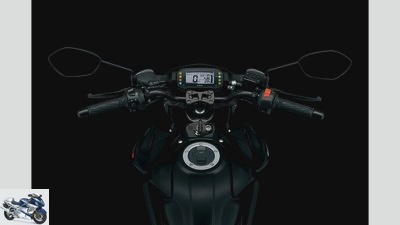
Suzuki
28/52
The handlebars on the GSX-S 125 are 10 cm higher than on the GSX-R 125 and are positioned closer to the driver.
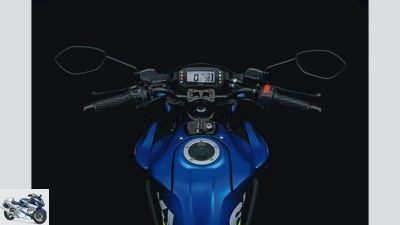
Suzuki
29/52
The LCD cockpit of the Suzuki GSX-S 125 offers many functions – including an oil change reminder.
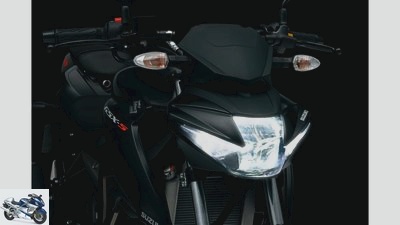
Suzuki
30/52
The units for low beam and high beam, as well as the position lights, which are arranged one above the other, are designed using LED technology.
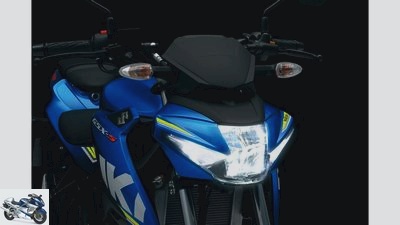
Suzuki
31/52
Clear glass indicators are intended to underline the modern design.
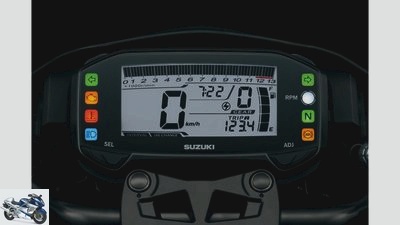
Suzuki
32/52
The cockpit of the Suzuki GSX-125 is framed by control LEDs.
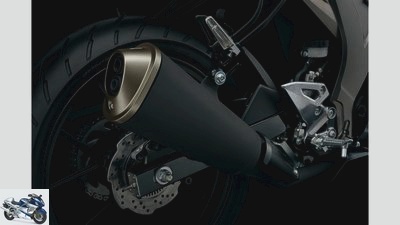
Suzuki
33/52
Engine with one cylinder, exhaust with two mouths. Just a design gimmick or technically lined? The Suzuki GSX-S 125 will know.
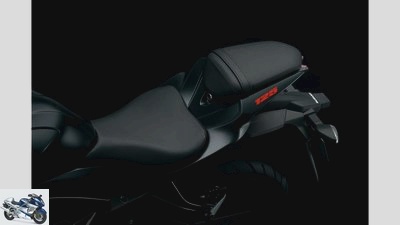
Suzuki
34/52
Other components must feel responsible for driving comfort on the Suzuki GSX-S 125; the seat cushions are apparently not.
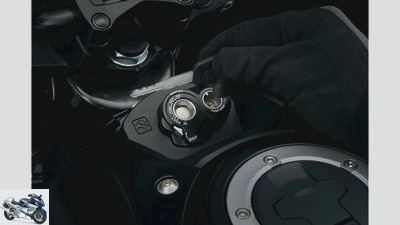
Suzuki
35/52
Easier keying in, even when wearing gloves, thanks to Suzuki’s intelligent ignition lock.
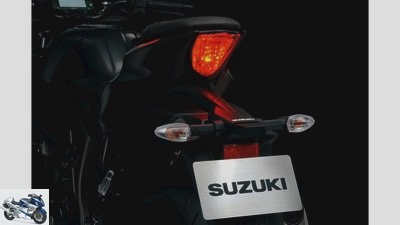
Suzuki
36/52
The Suzuki GSX-S 125 consistently implements its design line right through to the rear.
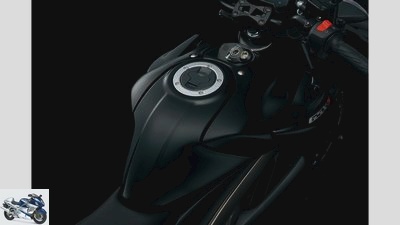
Suzuki
37/52
11 liter tank volume …
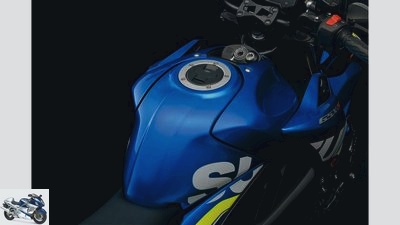
Suzuki
38/52
… and a record-breaking low fuel consumption, Suzuki attests to the GSX-S 125.
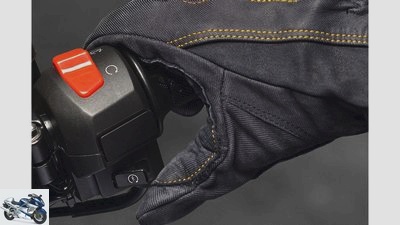
Suzuki
39/52
The servo starter of the Suzuki GSX-S 125 only needs a short push; the driver does not have to hold it until the engine has started.
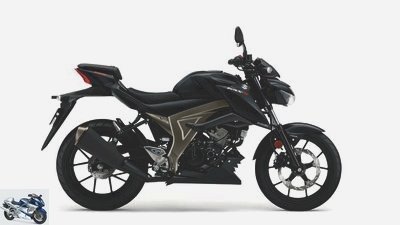
Suzuki
40/52
Suzuki GSX-S 125 at EICMA 2016.
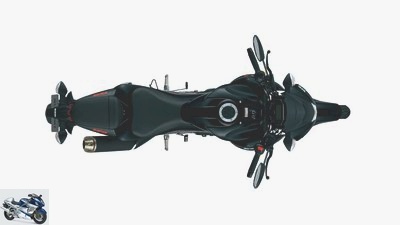
Suzuki
41/52
Suzuki GSX-S 125 at EICMA 2016.

Suzuki
42/52
Suzuki GSX-S 125 at EICMA 2016.
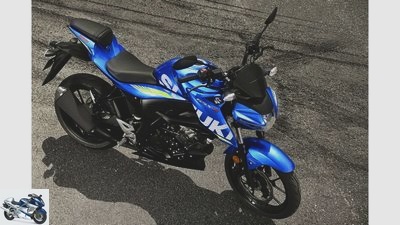
Suzuki
43/52
Suzuki GSX-S 125 at EICMA 2016.
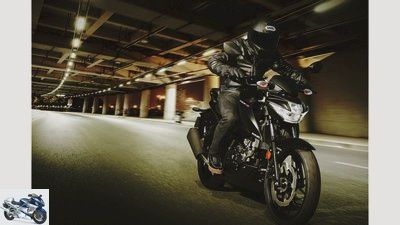
Suzuki
44/52
Suzuki GSX-S 125 at EICMA 2016.
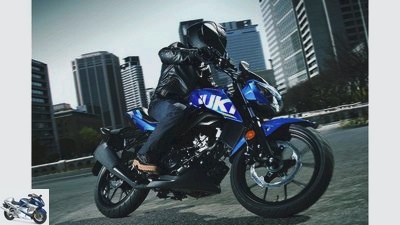
Suzuki
45/52
Suzuki GSX-S 125 at EICMA 2016.
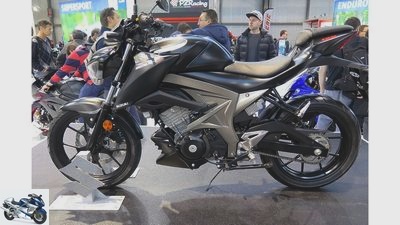
Niewrzol
46/52
Suzuki GSX-S 125 at EICMA 2016.
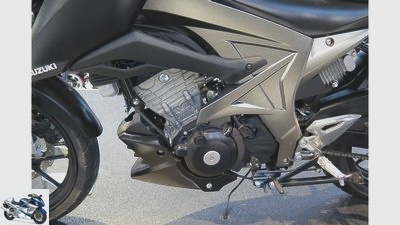
Niewrzol
47/52
Suzuki GSX-S 125 at EICMA 2016.
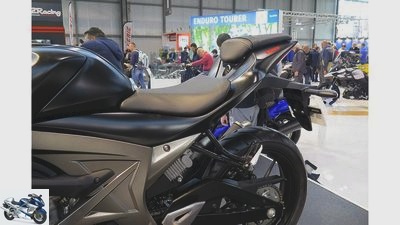
Niewrzol
48/52
Suzuki GSX-S 125 at EICMA 2016.
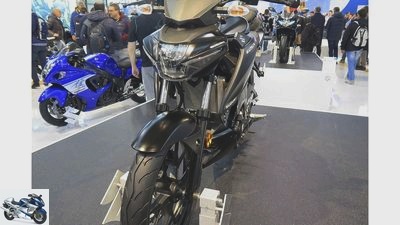
Niewrzol
49/52
Suzuki GSX-S 125 at EICMA 2016.
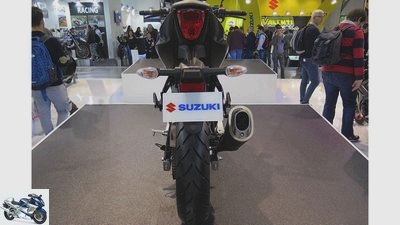
Niewrzol
50/52
Suzuki GSX-S 125 at EICMA 2016.

Niewrzol
51/52
Suzuki GSX-S 125 at EICMA 2016.
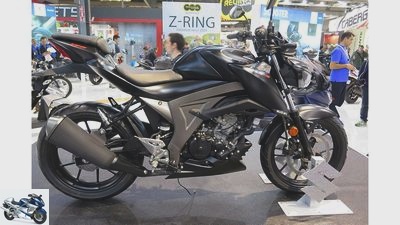
Niewrzol
52/52
Suzuki GSX-S 125 at EICMA 2016.
Suzuki GSX-S 125 (2017)
Gap closed
The Suzuki GSX-S 125 expands the brand’s 125 range. Just like its big sisters, it is based on an athlete, but does not have full disguise.
The Suzuki GSX-S 125 consistently brings the idea of the series into the light-power class: a naked bike with a sporty basic layout, compact chassis and dynamic design.
According to the manufacturer, the liquid-cooled dohc single cylinder of the Suzuki GSX-S 125 is said to be the most powerful engine in its class; its short-stroke design, its 32 mm throttle valve and the use of four valves suggest high speeds. Suzuki does not have exact power and torque values for the time being, but it should easily reach the 15 HP allowed in this class – a certain model from Austria finally manages this with a significantly less short-stroke design.
In addition, the Suzuki GSX-S 125 is the lightest representative of its class, which means that it logically offers the best power-to-weight ratio and the best acceleration. Nevertheless, the developers want to have paid attention to consumption; The Suzuki GSX-S 125 is therefore an economical vehicle for all sporty talents.
The Suzuki GSX-S 125 wants to achieve this with the help of injection electronics, which use the sensor data from the lambda probe, coolant temperature, temperature and pressure of the intake air, the throttle grip position and the crankshaft position to calculate the ideal injection quantities and times. The injection nozzle is aimed directly at the two inlet valves.
Suzuki GSX-R 125 with 10 cm higher handlebars
The equipment includes LED headlights, a servo starter, an exhaust with double mouth, aggressively styled brake discs and cast light alloy wheels. A Bosch ABS increases safety when decelerating sharply; its components weigh in at just 590 grams. The LCD cockpit offers a tachometer, speedometer, gear indicator, time clock, two daily and a total kilometers counter, shows the average consumption, the tank level and an indication of an oil change that is due a general error message frame the ensemble.
In contrast to its sister model GSX-R 125, the handlebars of the GSX-S 125 are a full 10 cm higher and a little closer to the driver. This results in a significantly more upright sitting position and a completely different driving experience.
The Suzuki GSX-S 125 will be available in black, red and a racing decor.
Read more about the Suzuki GSX 250 R, DL 250, GSX-S 125 and Burgman 400 in English
Technical data Suzuki GSX-S 125
Drive: Liquid-cooled single-cylinder four-stroke engine, 2 overhead camshafts, 4 valves, bore / stroke 62 / 41.2 mm, 125 cm³, compression 11: 1
Landing gear: Steel frame, telescopic fork, two-arm swing arm with indirectly hinged central spring strut
Wheels and brakes: Ten-spoke wheels made of cast light alloy, front tires 90 / 80-17, rear 130 / 70-17, 290 mm single-disc brake with single-piston floating caliper at the front, 187-mm single-disc brake with single-piston floating caliper at the rear, ABS
Measurements and weight: Length / width / height 2020/745/1040 mm, wheelbase 1300 mm, seat height 785 mm, tank capacity 11 liters, weight 133 kg
Related articles
-
Motorcycle fair in Milan EICMA 2019 Presented by Niewrzol 21st photos Suzuki 1/21 Suzuki GSX 250 R at EICMA 2016. Suzuki 2/21 Suzuki GSX 250 R at EICMA…
-
Suzuki GSX-R 125 and Suzuki GSX-S 125 in the driving report
Suzuki 17th photos Suzuki 1/17 Suzuki GSX-R 125. Suzuki 2/17 Suzuki GSX-R 125. Suzuki 3/17 Suzuki GSX-R 125. Suzuki 4/17 Suzuki GSX-R 125. Suzuki 5/17…
-
Suzuki GSX-S 1000 in the top test
Kunstle 35 Bilder Kunstle 1/35 Despite the jagged radiator cowling, round shapes dominate the GSX-S. The swing arm comes unchanged from the …
-
Driving report Suzuki GSX-S 750
Suzuki 14th photos Suzuki 1/14 Suzuki GSX-S 750 Suzuki 2/14 The LCD cockpit offers a wealth of information. It comes from the GSX-S 1000 Suzuki 3/14…
-
The paparazzo: Suzuki GSX-S 1000
Hohne innovations: Suzuki GSX-S 1000 sister S GSX-S 1000 instead of GSR 1000: MOTORRAD was wrong with the name, but by the way, Suzuki’s big naked …
-
Suzuki motorcycle GSX-S 1000 from 2016 – technical data
Suzuki motorcycle GSX-S 1000 technical data from 2016 technical data engine number of cylinders, type 4, in-line engine output 107.0 kW / 145.5 PS at 10,000 …
-
Suzuki motorcycle GSX-S 1000 F from 2015 – technical data
Suzuki motorcycle GSX-S 1000 F technical data from 2015 technical data engine number of cylinders, type 4, in-line engine output 107.0 kW / 145.5 PS at 10,000 …
-
New items 2019 Top topic Haojue 7th photos Haojue 1/7 Suzuki is obviously working on the entry into the sporty 300 class. Haojue 2/7 At Haojue, Suzuki’s…
-
Suzuki motorcycle GSX-S 1000 F from 2016 – technical data
Suzuki motorcycle GSX-S 1000 F technical data from 2016 technical data engine number of cylinders, type 4, in-line engine output 107.0 kW / 145.5 PS at 10,000 …
-
Triumph Speed Triple S against Suzuki GSX-S 1000 in comparison test
Rivas 19 pictures Arturo Rivas 1/19 picture gallery: Triumph Speed Triple vs. Suzuki GSX-S 1000. Arturo Rivas 2/19 The popular biker greeting wins …